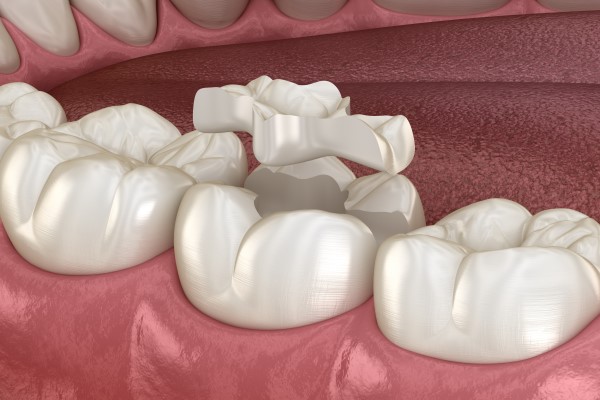Fixed Dentistry: Inlays and Onlays for Restoring a Tooth

Inlays and onlays are procedures under fixed dentistry for restoring a damaged tooth. Inlays and onlays are recommended when the damage to a tooth is too severe for a dental filling but is not bad enough to require a dental crown. Using fillings when inlays or onlays are required will only cause further tooth decay, which may ultimately need a root canal.
What are inlays and onlays?
Inlays and onlays are used for repairing tooth damages caused by cavities. They are bigger than dental fillings but smaller than dental crowns. The difference between an inlay and onlay is that an inlay lies within the tooth cusps, while onlays are used when the tooth cusps are also damaged.
The procedure involves making an impression of the affected tooth and producing the restoration outside the mouth. Dentists recommend the procedure for patients who have significant tooth decay that cannot be repaired with dental fillings. It is important to correct such issues on time because ignoring the problem can lead to more severe tooth damages.
There is also the option of using digital technology (CAD/CAM) to produce the inlay and onlay restorations. This method is preferred because it allows the patient to get a perfectly fitted dental restoration within one or two dental visits. If the inlay or onlay is produced in a dental lab, two appointments will be required. These restorations are highly conservative because it allows the dentist to save the tooth without removing a significant portion of the tooth structure.
Placing the inlay or onlay
There are two types of inlays and onlays: direct and indirect. Before commencing the restoration procedure, the dentist will remove the decayed portion of the tooth. For an indirect restoration, the dentist will apply a temporary filling if the restorations will be created in a dental lab. At the second appointment, the dentist will remove the temporary filling and cement the inlay and onlay permanently to the tooth.
For a direct restoration, the dentist will mold composite resin to fit the tooth. The inlay or onlay is then removed and cured in a special oven. Once the hardening process is complete, the dentist will bond the inlay or onlay to the tooth and polish it to look natural.
Points to consider
The dentist will determine the appropriate treatment for the patient based on how much of the tooth’s structure is remaining. There are many advantages of getting an onlay or inlay instead of traditional fillings. First, they are highly durable and can last several years with proper care. Also, they improve the strength of the tooth, ultimately increasing its lifespan and preventing the need for other fixed dentistry procedures like dental crowns or bridges.
In conclusion
If you have a damaged tooth, do not hesitate to contact the general dentist to discuss fixed dentistry restorations such as inlays or onlays to repair the tooth. After getting the dental restoration, proper oral care is necessary to maintain oral health to prolong the lifespan of the inlay or onlay.
Request an appointment here: https://smilesonmichigan.com or call Smiles On Michigan at (312) 509-9492 for an appointment in our Chicago office.
Check out what others are saying about our services on Yelp: Read our Yelp reviews.
Recent Posts
A smile makeover may be the answer for people who are embarrassed to show their teeth. A makeover consists of one or more dental procedures that treat or cover up imperfections with the gums or teeth. There are various methods that a dentist may use to change the appearance of one's smile, and they range…
Invisalign® is a discreet teeth-straightening method. Research shows that many people prefer this method to traditional braces. The clear aligners offer a more comfortable way to align teeth. Knowing when to choose Invisalign can help you prepare for your upcoming appointments.The metal wires and brackets of traditional braces can cause scrapes and holes in the…
Dental bonding is a reversible dental procedure that involves using a composite resin material to rebuild and restore teeth. The composites used can be matched with the color of the patient’s teeth, allowing restorations made with them to blend in.Dental bonding has cosmetic and restorative uses in dentistry. Unlike other popular restorations dentists use, its…
Wondering what a cosmetic dentist can do for your smile? Read on to learn more. A great smile can be a big self-esteem booster and a way to leave good first impressions. However, not all people have an aesthetically pleasing smile. Fortunately, a cosmetic dentist can help you improve the appearance of your teeth, gums,…